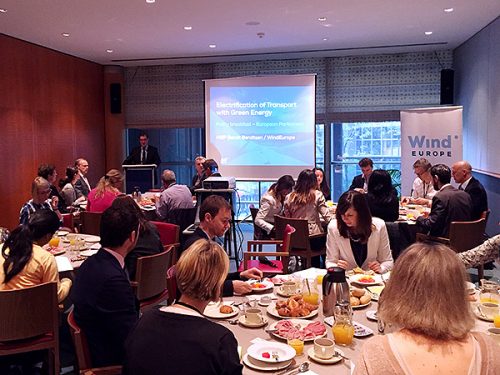5 May 2017
WindEurope discusses decarbonisation of transport with Members of European Parliament

The decarbonisation of transport and its integration into the electricity system is a cornerstone of the energy transition. But we have to ensure the power that is driving electro-mobility is clean. Today 29% of the electricity consumed in Europe comes from renewables, by 2030 this share is due to reach 50%. This means the acceleration of electric vehicle (EV) deployment will coincide with the decarbonisation of the power sector.
On 3 May, WindEurope organised a breakfast discussion in the European Parliament in cooperation with MEP Bendt Bendtsen (EPP – Denmark).
 WindEurope CEO Giles Dickson stressed that electric engines are more energy efficient per distance driven than internal combustion engines. Today, only 1% of the vehicles sold around the world are electric. But market trends are moving fast. In Norway, electric vehicles constituted nearly 40% of the nation’s newly registered passenger cars in 2016. Dickson highlighted that the role of wind energy in this transition is crucial. It will ensure that the power driving electric transport is clean. He urged policy makers to accelerate the transition through the EU Clean Energy Package. They should increase the minimum share of alternative fuels and renewable electricity that fuel suppliers provide in a calendar year. And they should uphold proposals to equip all new and renovated residential buildings with pre-cabling, which would make it easier for citizens to install electric vehicle charging points at home in the future.
WindEurope CEO Giles Dickson stressed that electric engines are more energy efficient per distance driven than internal combustion engines. Today, only 1% of the vehicles sold around the world are electric. But market trends are moving fast. In Norway, electric vehicles constituted nearly 40% of the nation’s newly registered passenger cars in 2016. Dickson highlighted that the role of wind energy in this transition is crucial. It will ensure that the power driving electric transport is clean. He urged policy makers to accelerate the transition through the EU Clean Energy Package. They should increase the minimum share of alternative fuels and renewable electricity that fuel suppliers provide in a calendar year. And they should uphold proposals to equip all new and renovated residential buildings with pre-cabling, which would make it easier for citizens to install electric vehicle charging points at home in the future.
The Energy Performance of Buildings Directive (EPBD) is another key legislative instrument for the energy transition in the transport sector. MEP Bendt Bendtsen, the rapporteur for the EPBD, said building the necessary charging infrastructure is key on the road towards a comprehensive electrification of the transport sector. He hopes to see a strong majority for the legislative proposal in the European Parliament. In particular for the provision that aims to equip 1 in every 10 parking slots in new and renovated non-residential buildings with smart charging points. Silvia Bartolini, Member of Cabinet of EU Commissioner Arias Cañete, explained the rationale for the Commission’s proposal on the EPBD. And said new proposals on emissions of cars will also make a substantial contribution in the near future. She stressed the European transport sector needs to become clean, competitive and connected.
Many WindEurope members are already paving the way towards clean transport. Susanne Rompel, Head of EU Representation at Innogy, presented the company’s charging solutions. She stressed the need for a truly pan-European approach to the electrification of transport. It needs to take into account the consumers’ needs as well as the latest IT developments. Connectivity technologies for charging the vehicles, including e-payment and roaming, is the future. Folker Franz, Senior Vice-President EU Government Relations at ABB Europe, said the mobility of the future goes beyond electric cars. Not only cars but other means of transportation, like buses and shipping, will be touched by this revolution. He also highlighted the need to strengthen the electricity grid. In the near future, the network needs to be able to cope with the high power demand of fast-charging vehicles.

